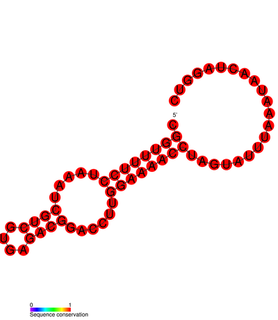Circoviridae is a family of DNA viruses. Birds and mammals serve as natural hosts. There are 101 species in this family, assigned to 2 genera. Diseases associated with this family include: PCV-2: postweaning multisystemic wasting syndrome; CAV: chicken infectious anemia.

Nanoviridae is a family of viruses. Plants serve as natural hosts. There are currently 12 species in this family, divided among 2 genera and one unassigned species. Diseases associated with this family include: stunting. Their name is derived from the Greek word νᾶνος, because of their small genome and their stunting effect on infected plants.

Closteroviridae is a family of viruses. Plants serve as natural hosts. There are four genera and 59 species in this family, seven of which are unassigned to a genus. Diseases associated with this family include: yellowing and necrosis, particularly affecting the phloem.

Nodaviridae is a family of nonenveloped positive-strand RNA viruses. Vertebrates and invertebrates serve as natural hosts. Diseases associated with this family include: viral encephalopathy and retinopathy in fish. There are nine species in the family, assigned to two genera.

Tymoviridae is a family of single-stranded positive sense RNA viruses in the order Tymovirales. Plants serve as natural hosts. There are 42 species in this family, assigned to three genera, with two species unassigned to a genus.

Erythroparvovirus is a genus of viruses in subfamily Parvovirinae of the virus family Parvoviridae. Primates serve as natural hosts. There are seven species in this genus. Diseases associated with this genus include fifth disease and skin lesions.

Globuloviridae is a family of hyperthermophilic archaeal viruses. Crenarchaea of the genera Pyrobaculum and Thermoproteus serve as natural hosts. There are four species in this family, assigned to a single genus, Alphaglobulovirus.

Alphaflexiviridae is a family of viruses in the order Tymovirales. Plants and fungi serve as natural hosts. There are 65 species in this family, assigned to six genera. Diseases associated with this family include: mosaic and ringspot symptoms.

Betaflexiviridae is a family of viruses in the order Tymovirales. Plants and fungi serve as natural hosts. There are 108 species in this family, assigned to 13 genera in two subfamilies. Diseases associated with this family include: mosaic and ringspot symptoms.
Betapapillomavirus is a genus of viruses, in the family Papillomaviridae. Human serve as natural hosts. There are six species in this genus. Diseases associated with this genus include warts, papilloma, and malignant tumours.

Caulimovirus is a genus of viruses, in the family Caulimoviridae order Ortervirales. Plants serve as natural hosts. There are 12 species in this genus. Diseases associated with this genus include: vein-clearing or banding mosaic.
Cavemovirus is a genus of viruses, in the family Caulimoviridae order Ortervirales. Plants serve as natural hosts. There are three species in this genus. Diseases associated with this genus include: vein-clearing or banding mosaic.
Deltapapillomavirus is a genus of viruses, in the family Papillomaviridae. Ruminants serve as natural hosts. There are seven species in this genus. Diseases associated with this genus include: warts of the skin and alimentary tract ; possibly responsible for the skin tumour equine sarcoid in horses and donkeys.
Epsilonpapillomavirus is a genus of viruses, in the family Papillomaviridae. Cattle serve as natural hosts and it is one of the bovine papillomaviruses. There are two species in this genus. Diseases associated with this genus include: fibropapillomas and true epithelial papillomas of the skin.
Iotapapillomavirus is a genus of viruses, in the family Papillomaviridae. Rodents serve as natural hosts. There are two species in this genus. Diseases associated with this genus include: cutaneous lesions and benign skin tumours, such as papillomas and keratoacanthomas.
Iteradensovirus is a genus of viruses in the subfamily Densovirinae of the family Parvoviridae. Insects serve as natural hosts. There are five species in this genus.
Lambdapapillomavirus is a genus of viruses, in the family Papillomaviridae. Cats and dogs serve as natural hosts. There are five species in this genus. Diseases associated with this genus include: mucosal and cutaneous lesions.
Mupapillomavirus is a genus of viruses in the family Papillomaviridae. Humans serve as natural hosts. There are three species in this genus. Diseases associated with this genus include palmoplantar warts.
Xipapillomavirus is a genus of viruses, in the family Papillomaviridae. Bovine serve as natural hosts. There are five species in this genus. Diseases associated with this genus include: true papillomas on the cutaneous or mucosal surfaces of cattle.

Nyamiviridae is a family of negative-strand RNA viruses in the order Mononegavirales. Ecdysozoa and birds serve as natural hosts. The name is a portmanteau of Nyamanini Pan and Midway Atoll and the suffix -viridae used to denote a virus family. There are seven genera in this family.











